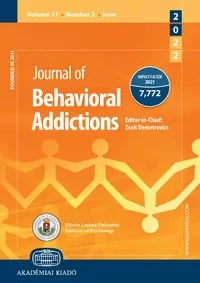Prefrontal cortical activation in Internet Gaming Disorder Scale high scorers during actual real-time internet gaming: A preliminary study using fNIRS
Prefrontal cortical activation in Internet Gaming Disorder Scale high scorers during actual real-time internet gaming: A preliminary study using fNIRS
Author(s): Tae Hun Cho, Yoonjin Nah, Soo Hyun Park, Sanghoon HanSubject(s): Behaviorism
Published by: Akadémiai Kiadó
Keywords: internet gaming disorder; fNIRS; real-time internet gaming; addiction; dorsolateral prefrontal cortex; orbitofrontal cortex
Summary/Abstract: Background. Observation of real-time neural characteristics during gameplay would provide distinct evidence for discriminating the currently controversial diagnosis of internet gaming disorder (IGD), and elucidate neural mechanisms that may be involved in addiction. We aimed to provide preliminary findings on possible neural features of IGD during real-time internet gaming using functional near-infrared spectroscopy (fNIRS). Methods. Prefrontal cortical activations accompanying positive and negative in-game events were investigated. Positive events: (1) participant’s champion slays or assists in slaying an opponent without being slain. (2) the opposing team’s nexus is destroyed. Negative events: (1) participant’s champion is slain without slaying or assisting in slaying any opponent. (2) the team’s nexus is destroyed. Collected data were compared between the IGD group and control group, each with 15 participants. Results. The IGD group scored significantly higher than the CTRL group on the craving scale. Following positive events, the IGD group displayed significantly stronger activation in the DLPFC. Following negative events, the IGD group displayed significantly weaker activation in the lateral OFC. Discussion and Conclusions. Individuals scoring high on the IGD scale may crave for more internet gaming after encountering desired events during the game. Such observations are supported by the correlation between the craving scale and DLPFC activation. The IGD group may also show diminished punishment sensitivity to negative in-game experiences rendering them to continue playing the game. The present study provides preliminary evidence that IGD may demonstrate neural characteristics observed in other addictive disorders and suggests the use of fNIRS in behavioral addiction studies.
Journal: Journal of Behavioral Addictions
- Issue Year: 11/2022
- Issue No: 2
- Page Range: 492-505
- Page Count: 14
- Language: English

